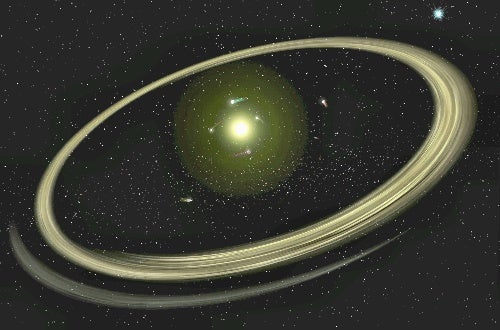New observations with NASA’s Spitzer Space Telescope suggest making planets around a star unfolds over longer timescales and with more violence than astronomers previously thought. The observations also imply earthlike planets may be relatively common.
Astronomer George Rieke of the University of Arizona led a team of researchers who used the infrared-sensitive Spitzer Space Telescope to survey 266 young stars within 500 light-years of Earth. The stars range in age from a few million to 800 million years old and have masses averaging about 2.5 times that of the Sun.
Of this sample, the team found 71 of the stars — more than one in every four — are surrounded by disks of dust. “The dust gets warmed by the star,” says Rieke, “and we pick it up with Spitzer.”
These disks are not remnants of the protostellar clouds from which the stars themselves formed, according to the astronomers, who plan to publish in The Astrophysical Journal. Instead, they say, the dust comes from collisions among rocky bodies roughly 100 miles (160 kilometers) in diameter.
“What Spitzer is seeing isn’t even the tip of the iceberg,” notes Rieke. “To make the amount of dust that must be present, you have to have lots of big objects orbiting these stars and colliding with each other. These are really grinding, catastrophic events.” The team also notes the debris disks they observed occur at various distances from their stars.
Dust has a short lifetime in orbit because it gets pulled into the star or it collides with other debris and sticks. Or, if it’s small enough, it gets blown out of the system by the pressure of starlight.
Rieke says, “This means these systems are each dominated by a single, large collision that occurred recently on an astronomical timescale — within the last few million years. These systems can’t have been the way they are now for very long.”
Rough ride
Given the age-range of the sample, the astronomers were surprised that even late in planet formation, big collisions still occur. One star in the study with an age of about 330 million years has a large dust disk. By that point in a star system’s history, the prevailing view was that evolution would be generally quiescent.
Says Rieke, “Not only do we have a handle on the period when big collisions happen, but we find many systems don’t evolve smoothly.”
Scott Kenyon, a planet-formation theorist at the Smithsonian Astrophysical Observatory in Cambridge, Massachusetts, concurs. “Violent collisions may be more frequent than we had thought before.”
Cosmic dust bunnies
Kenyon notes that planet formation begins with dust particles about the size of sand grains. “These collide and merge into rocks a mile or so across,” he says. “The dust bunnies under your bed grow in a similar way — and after a million years or so, a dust bunny could get pretty big.”
Once large rocks form, collisions among them make planets, and once planets form, collisions with leftover rocks make the bright, warm rings of dust detected by Spitzer and other infrared telescopes. For example, a team of Japanese astronomers recently used infrared spectrascopy to discover a new dust ring and a possible planet around Beta (β) Pictoris.
Rieke says, “At the wavelengths we’re using with Spitzer, we’re looking at zones around these stars where we’d see the familiar earthlike planets if it were our own solar system. We’re probing processes that go into making planets like Earth and Mars rather than, say, Uranus, Pluto, and so on.”
How common are solar systems like ours? It’s hard to say, but Scott Kenyon thinks the chances have increased thanks to the new findings. “These observations show that many stars have the debris of terrestrial-planet formation.” He continues, “It gives us hope that forming terrestrial planets is common.”
Impact on life
If big collisions continue well past the beginning stages of a solar system, this has implications for the origin of life. The Moon originated when a Mars-size planetesimal struck the early Earth 4.5 billion years ago, raising both bodies to sterilizing temperatures. But the geological record also shows that Earth suffered large impacts long after life had begun: Canada’s Sudbury impact crater (1.9 billion years ago) and Mexico’s Chicxulub crater (65 million years ago), to name just two.
The new findings from Rieke’s team offer an astrophysical context for the solar system’s experience — and they suggest that because life here emerged amid a rain of rocky debris, having a similar period of collisions and impacts should not prevent life from appearing elsewhere.
“We’re not sure what conditions were necessary for life to form,” says Rieke. “But this is a nice step along the road — it’s a journey we’ve just begun.”
Kenyon adds, “Spitzer’s observations show us that violent collisions are part of the history of all solar systems. In our solar system, we see only the relics of its past history. By observing stars of different ages, we can see snapshots of our own history. … It’s a thrilling time.”











